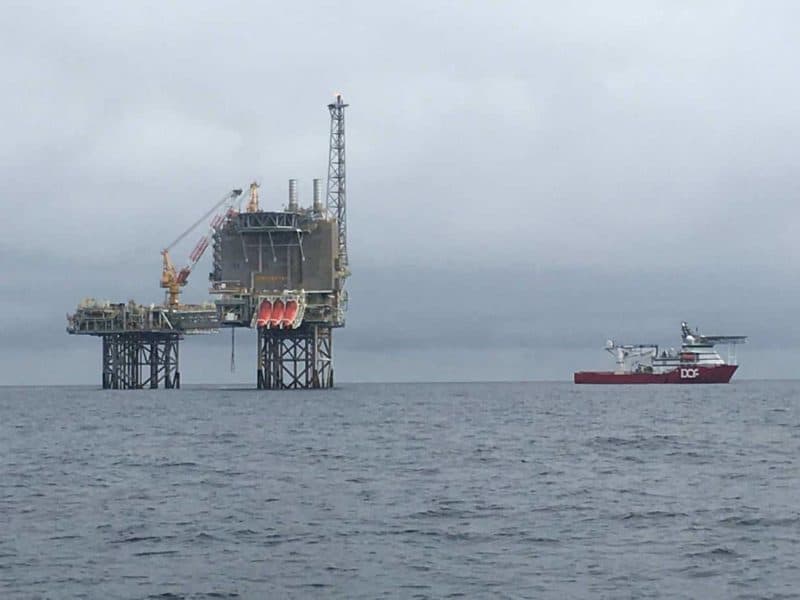A survey of offshore installations extracting oil and natural gas in the North Sea revealed far more leakage of methane, a powerful greenhouse gas, than currently estimated by the British government, according to a research team led by scientists from Princeton University.
Using a laser-based instrument mounted on small fishing boats, the researchers estimated methane emissions from eight North Sea production platforms off the coasts of England and Scotland. Contrary to current expectations, they found that all the sampled offshore installations leaked even when they were not conducting operations expected to cause methane emissions. On average, methane leakage occurring during normal operations more than doubles each installations’ reported emissions to the U.K.’s National Atmospheric Emission Inventory.
In an article published Aug. 2 in the journal Atmospheric Chemistry and Physics, the researchers noted that previously reported leakage from operating oil and gas platforms appear low: 0.13% of production by U.K. government estimates. However, the researchers found that an additional 0.19% occurred during normal operations. For the U.K., this additional 0.19% corresponds to an additional 330,000 cars on the road (an increase of 1% in registered U.K. vehicles), the researchers said.
The large number of offshore platforms around the globe make careful measurement and analysis of leakage critical for global emissions inventories and for mitigating climate change, the researchers said. Methane, the primary component of natural gas, is both a greenhouse gas and a contributor to smog. The amount of methane in the atmosphere has roughly doubled since 1850, mostly due to human activity. Until now, the researchers said, offshore rigs have essentially been viewed as nearly 100% efficient, with no leakage of methane except during certain actions including releasing gas to control pressure inside wells or moving oil from rigs to ships. In the United Kingdom, for example, petroleum companies estimate leakage based on these actions and report the totals annually to the British government.
The researchers said the most recent findings raise concern that policymakers might not be receiving accurate estimates for methane leakage from off-shore oil and gas rigs.
“As the world attempts to rapidly decarbonize the energy system, care must be taken to minimize unnecessary natural gas leakage from the production process during the transition away from fossil fuels,” said Denise Mauzerall, professor of civil and environmental engineering and public and international affairs at Princeton and the principle investigator for the project. “Our concern about this leakage led us to expand our work from conventional and abandoned wells in the United States to offshore oil and gas rigs in the North Sea.”
In summer 2017, Princeton researcher Stuart Riddick used a 30-foot sport fishing boat as a platform to measure methane emissions from North Sea offshore oil and gas installations. Riddick, an associate research scholar in the Department of Civil and Environmental Engineering, collected methane concentration data using a laser-based analyzer and mounted sensors on the boat to measure local weather conditions. The small boat circled outside the 500-meter exclusion zone around each site, sometimes avoiding service boats curious about the researchers’ purpose.
The researchers used readings from the analyzer, plus data on meteorological conditions, to estimate the amount of methane leaking from the rigs and to calculate average loss based on the rigs’ production. When they compared those numbers to the official estimates, they realized there was substantial leakage that was not included in the official estimates. Riddick said the .19 % was a conservative estimate and the actual leakage could be greater.
Riddick said the work demonstrates a method of directly monitoring leaks from offshore installations that could be used by industry and government. Policymakers, he added, could use a similar approach to more accurately assess total emissions from production sources, and the industry could also benefit from the technology.
“It was my hope that this study would change the way that the oil and gas industry views offshore installations and facilitate the development of new ways to reduce emissions,” Riddick said. With the experiment, he said, “we have shown that offshore methane emissions can be estimated when an installation is considered as a point source. Our work provides a method for estimating how much natural gas offshore oil rigs emit in remote parts of the globe. We hope this method can be used as a diagnostic tool by the oil and gas industry and regulators to actively measure emissions to identify leaks, reduce greenhouse gas emissions and improve company profits.”
Besides Mauzerall and Riddick, the authors of the paper include: Michael Celia, Princeton’s Theodora Shelton Pitney Professor of Environmental Studies; Professor Grant Allen, University of Manchester; Grant Forster, University of East Anglia; Professor Neil Harris, Cranfield University; Professor Mary Kang, McGill University; David Lowry, Royal Holloway, University of London; Alistair Manning, U.K. Met Office; Professor Euan Nisbet, Royal Holloway, University of London; Joseph Pitt, University of Manchester; and John Staunton-Sykes, University of Cambridge.
Support for the research was provided in part by the U.S. National Oceanic and Atmospheric Administration and the U.K. Natural Environment Research Council.


